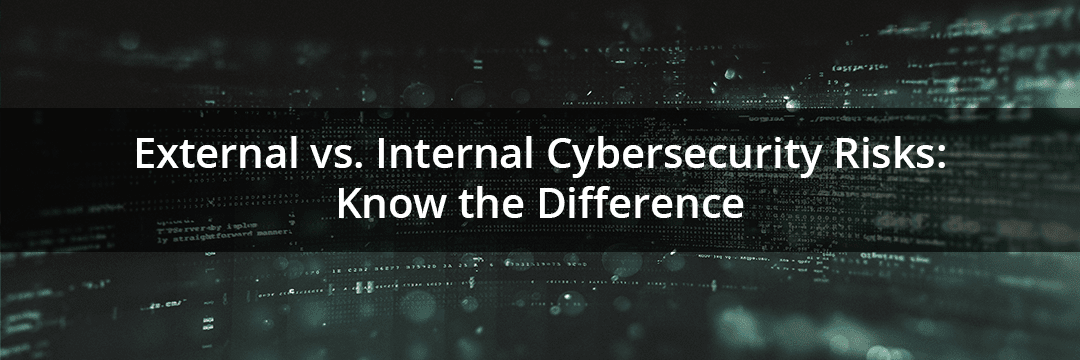External vs. Internal Cybersecurity Risks: Know the Difference
Most companies are under constant attack from external forces originating in the digital realm. You may think this sounds somewhat apocalyptic, as if when a major news outlet and a cybersecurity firm make this generalization it is used as some sort of scare tactic; however, it is anything but. ERMProtect has seen the change in the digital landscape and the escalation of cyber-attacks over the past few years. Cybersecurity firms are an emerging market for simply this reason: companies are beginning to notice the importance of protecting their valuable information, their customers, and their reputation and brand by preventing breaches.
External Cybersecurity Risk
Don’t think of the typical mobster or man with a black mask when you imagine these criminals. Cyber-criminals might be in their pajamas and in bed while their zero-day or brute force password attack constantly attacks your system looking for a way in; a thousand times a second; over and over until it gains access. These hackers are not only brilliant coders, but they understand how people work and they will find a way to hack your system if they try hard enough.
Malware, malvertizing, phishing, DDoS attacks, ransomware; these are just some of the viruses and methods that hackers use externally to gain access to your site, software, or network. Part of any good cybersecurity firm’s repertoire is the ability to deal with each of these issues and prevent external cybersecurity risks no matter what form they may come in.
After gaining access, these cybercriminals remain inside the system, sometimes for months, unnoticed and extracting information. Most are never found and even more are not discovered until a later date. You will face way more external attacks than internal, and the idea is to harden the perimeter to keep hackers out. Perimeters can be properly built with the right kind of penetration testing conducted by an experienced cybersecurity firm.
Internal Cybersecurity Risk
Internal data leaks stem from employees. Sometimes it can be hard to believe that an employee would willingly sabotage their own company, and although sometimes it happens willfully, most of the time it is purely accidental.
The main objective for cyber-criminals is to attain the credentials of an employee or admin, and then move through the network with complete access to everything. This is where employee training on cybersecurity becomes extremely valuable.
Which is worse?
They are both equally devastating, but it depends on the industry and what information is taken. If an employee sells secrets to a competitor and decides to deface the company's website, then damage to reputation and profits could be long-lasting and devastating, making internal hacks potentially more threatening than external. External hacks typically look for information they can sell or use to make a profit, so if a hacker penetrates your network or software, then hides valuable information and demands a ransom of money in return for releasing the information back to you – then external hacks could be monetarily more harmful.
How to Prevent Both
- Keep track of employee access levels and change them accordingly and frequently.
- Change passwords regularly and immediately after an employee leaves.
- Training: do not share passwords, do not reuse passwords, and ensure that passwords meet at least medium security level requirements.
What are the top types of external cyberattacks?
In 2020, there are 8 types of external cyberattacks that most commonly happen. Here’s what they are:
1. (DDoS) Distributed denial-of-service attacks
A DDoS attack happens when a network or system becomes overwhelmed and it cannot respond to service requests. A DDoS attack happens when a massive number of machines are directed to bombard the target with traffic. These machines are typically infected with viruses controlled by one over all attacker.
2. Session hijacking
This is a type of man-in-the-middle attack wherein there is a session hijacked between a network server and client. The bad actor, or attacker, replaces its IP address for the client’s and the server continues the session. During this attack, the server believes it is still communicating with the trusted client.
3. Drive-by attack
In a drive-by attack, malicious scripts spread malware around the web. Bad actors look for insecure websites and plant scripts in the code on one of the pages. Sometimes, the malicious scripts install malware on the computer of a web page visitor. In other cases, the hackers may redirect the visitor to a website that the hackers own, where they may be hacked. Drive-by downloads happen most commonly on web pages, pop-ups and emails.
4. Password attack
Since passwords are widely used to protect data on the web, they are a main area of attack for hackers and bad actors. Having a person’s password can open up all sorts of additional hacks. Hackers obtain passwords by “sniffing” the connection to a network to gain access to the passwords. Hackers also obtain passwords by using social engineering tactics, and physically looking around desks and offices.
5. Phishing and spear phishing attacks
A phishing attack is where hackers send emails that appear to be from a trusted source but can compromise personal information or use the hacker’s access to force the victim to do something. Phishing requires some social engineering and technical hacking. Email attachments with malware are common tools hackers use for phishing. Likewise, spear phishing is the practice of targeting a specific person or company in an attempt to obtain valuable information or exploit a person or company.
ERMProtect's Security Awareness Training Program
ERMProtect has over 25 years of experience in cybersecurity, where we combat both internal and external cybersecurity risks. Our cybersecurity experts implement proactive solutions to improve current systems and create new ones. To speak with someone on our cybersecurity team, please call (800) 259-9660 or click here to schedule a free demo.

Turn your employees into a human firewall with our innovative Security Awareness Training.
Our e-learning modules take the boring out of security training.

Get a curated briefing of the week's biggest cyber news every Friday.
Intelligence and Insights

Are You Prepared for an AI-Powered Cyber Attack?

AI Privacy Risks


